This Is Exactly How Many Grams Of Sugar You Should Eat Per Day
And how to stay under the limit, dessert included.

Sugar is everywhere, and it's sneaky. There's sugar in your favorite drinks, yogurt and even granola. Sugar intake has become such a big problem that the U.S. Departments of Agriculture and Health and Human Services updated the official Dietary Guidelines last year to cap on how much added sugar we should consume every day. And keeping it below that line (and preventing all kinds of major health problems, including heart disease and diabetes) can be a challenge.
The goal? No more than 12 teaspoons (or about 50 grams) of added sugars per day. Note that this is about added or "free" sugars, not naturally occurring sugars in fruit and vegetables, which groups like the World Health Organization (WHO) say are less of a health issue. But how are we supposed to tell the difference between added and natural sugars? Luckily, newly designed nutrition labels will be a huge help: Added sugars will be separated from the total sugar count, so it will be much easier to spot foods packed with the sweet stuff.
"Ultimately, you can 100% eat dessert every day if you cut out the sneaky sources of added sugar in your diet," says Jaclyn London, MS, RD, CDN, Nutrition Director at the Good Housekeeping Institute. "Check labels religiously, but on the whole, sauces, condiments, dairy products, breads, crackers and beverages are some places you might not expect to find sugar."
To give you a better idea of what 50 grams of total sugar in a day look like, we pulled together a full-on feast that's totally nom-worthy.


Walmart Recalls Nearly 1 Million Water Bottles

Restaurants Offer Major Discounts In Response To McDonald's Snack Wrap Return

The Worst Things Health Inspectors Have Seen

I Tried McDonald's Snack Wrap After Its Decade-Long Hiatus














